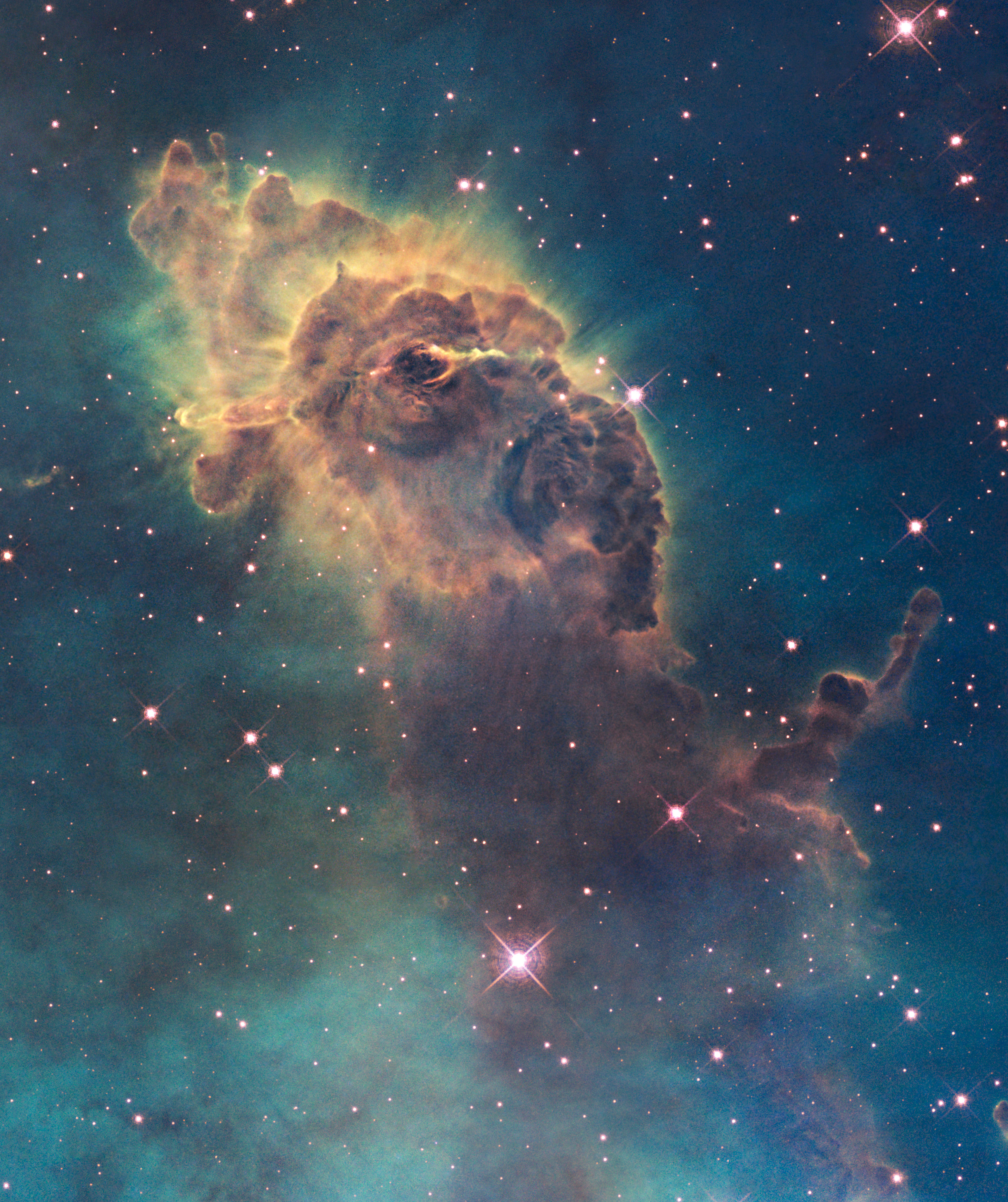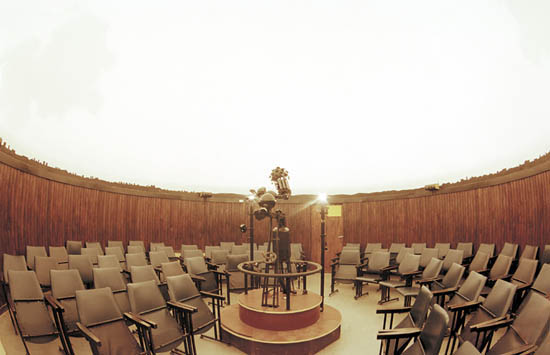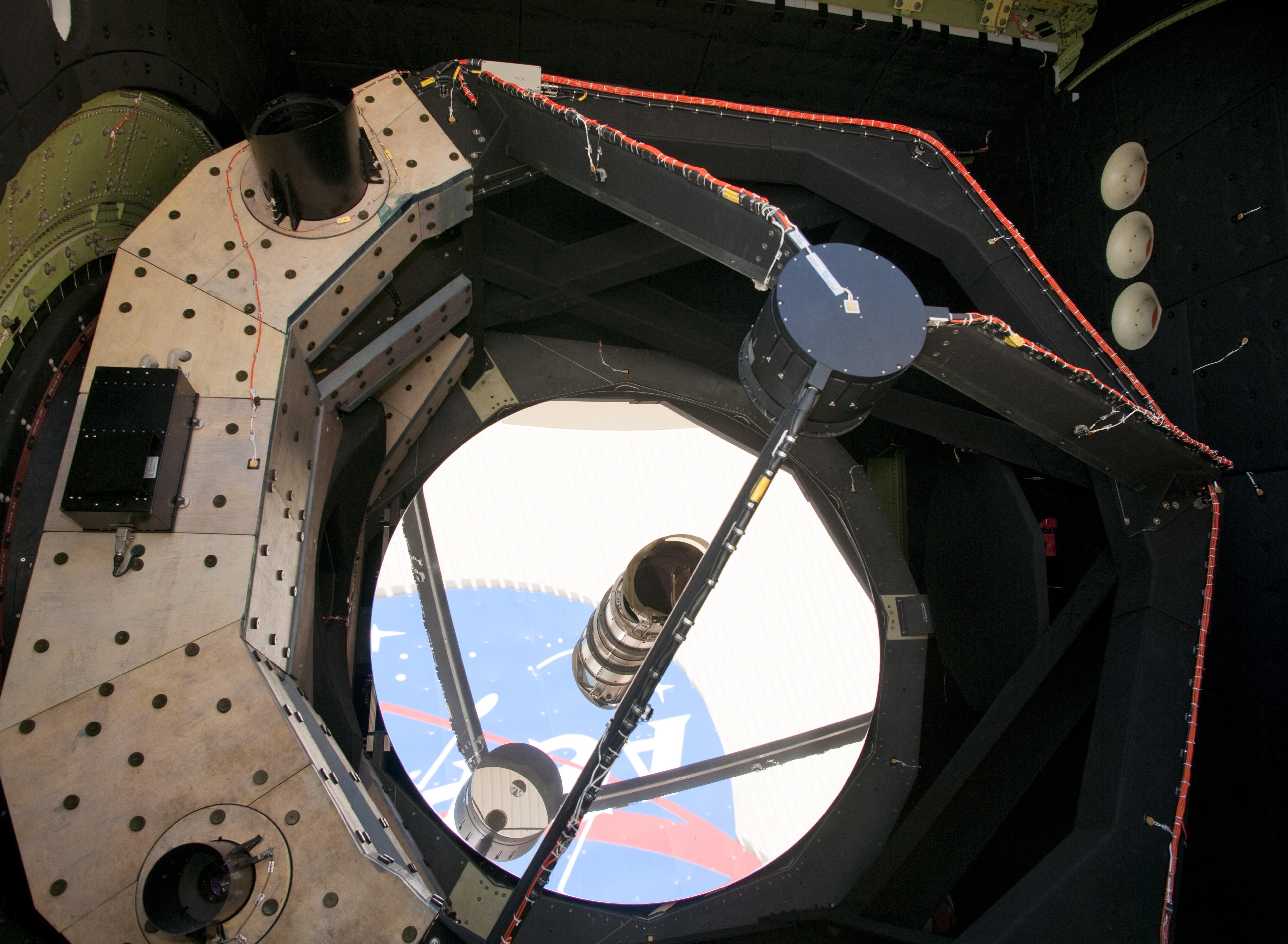|
Rainwater Observatory
Rainwater Observatory and Planetarium is an educational astronomical observatory and Planetarium run as an educational ministry of French Camp Academy. It is located near French Camp, Mississippi, United States. It is the largest observatory in Mississippi with 16+ telescopes, with the largest instruments including a 32-inch Dobsonian telescope and 14-inch Celestron catadioptric telescope. Rainwater is currently awaiting delivery of the Sollee Telescope, a 25-inch research-grade telescope. When installed in the two-story observatory building already constructed in the observatory complex, the Sollee Telescope will be suitable for serious astronomical studies, in the last remaining "dark spot" in Mississippi on the U.S. Dark Skies photograph. Rainwater Observatory and Planetarium is the site for the annual Midsouth Star Gaze. This gathering of amateur astronomers is held in late March or early April each year on the weekend closest to New Moon (to allow for the maximum ... [...More Info...] [...Related Items...] OR: [Wikipedia] [Google] [Baidu] |
French Camp Academy
French Camp Academy (FCA) is an interdenominational Christian boarding home and academy in French Camp, Mississippi. It is intended to serve children and teenagers who need opportunities and resources not available in their home or peer environments FCA also serves young people in their area by providing an accredited Christian education for grades 7-12.Scherer, Dennis.Time travelers" CAMP: Visitors get a glimpse of the past in French Camp, Miss.) '' The Times Daily''. Tuesday May 23, 2000. 7A (continued from 1A). Retrieved from Google News (14 of 27) on February 28, 2011. The school operates several businesses in French Camp, including a bed and breakfast, a gift shop, and a restaurant. History A group of Scotch-Irish Christians, under the area Presbyterian Church, established the Central Mississippi Institute for Girls in 1885. The French Camp Academy for Boys opened later in 1885. [...More Info...] [...Related Items...] OR: [Wikipedia] [Google] [Baidu] |
Nebulae
A nebula ('cloud' or 'fog' in Latin; pl. nebulae, nebulæ or nebulas) is a distinct luminescent part of interstellar medium, which can consist of ionized, neutral or molecular hydrogen and also cosmic dust. Nebulae are often star-forming regions, such as in the "Pillars of Creation" in the Eagle Nebula. In these regions, the formations of gas, dust, and other materials "clump" together to form denser regions, which attract further matter, and eventually will become dense enough to form stars. The remaining material is then thought to form planets and other planetary system objects. Most nebulae are of vast size; some are hundreds of light-years in diameter. A nebula that is visible to the human eye from Earth would appear larger, but no brighter, from close by. The Orion Nebula, the brightest nebula in the sky and occupying an area twice the angular diameter of the full Moon, can be viewed with the naked eye but was missed by early astronomers. Although denser than the space su ... [...More Info...] [...Related Items...] OR: [Wikipedia] [Google] [Baidu] |
Planetaria In The United States
A planetarium ( planetariums or ''planetaria'') is a Theater (structure), theatre built primarily for presenting educational entertainment, educational and entertaining shows about astronomy and the night sky, or for training in celestial navigation. A dominant feature of most planetariums is the large dome-shaped celestial sphere, projection screen onto which scenes of stars, planets, and other astronomical object, celestial objects can be made to appear and move realistically to simulate their motion. The projection can be created in various ways, such as a Planetarium projector, star ball, slide projector, video, fulldome projector systems, and lasers. Typical systems can be set to simulate the sky at any point in time, past or present, and often to depict the night sky as it would appear from any point of latitude on Earth. Planetaria range in size from the 37 meter dome in St. Petersburg, Russia (called “Planetarium No 1”) to three-meter inflatable portable domes wher ... [...More Info...] [...Related Items...] OR: [Wikipedia] [Google] [Baidu] |
Astronomical Observatories In Mississippi
Astronomy () is a natural science that studies celestial objects and phenomena. It uses mathematics, physics, and chemistry in order to explain their origin and evolution. Objects of interest include planets, moons, stars, nebulae, galaxies, and comets. Relevant phenomena include supernova explosions, gamma ray bursts, quasars, blazars, pulsars, and cosmic microwave background radiation. More generally, astronomy studies everything that originates beyond Earth's atmosphere. Cosmology is a branch of astronomy that studies the universe as a whole. Astronomy is one of the oldest natural sciences. The early civilizations in recorded history made methodical observations of the night sky. These include the Babylonians, Greeks, Indians, Egyptians, Chinese, Maya, and many ancient indigenous peoples of the Americas. In the past, astronomy included disciplines as diverse as astrometry, celestial navigation, observational astronomy, and the making of calendars. Nowad ... [...More Info...] [...Related Items...] OR: [Wikipedia] [Google] [Baidu] |
List Of Planetariums
This entry is a list of permanent planetariums across the world, including software and manufacturers. In addition, many mobile planetariums exist, touring venues such as schools. Permanent planetariums The planetariums here are listed in the following format: ''name'', ''website'' (if available), ''city''. The International Planetarium Society has a much more complete list at its website. Africa Algeria * Complexe Culturel Abdelwahab Salim, Tipaza * Planetarium de Ghardaia, Ghardaia Egypt * Arab Academy for Science and Technology Planetarium, Alexandria * The Child Museum, Cairo * Planetarium Science Center, Alexandria * Suez Discovery & Science Center, Suez Ghana * Ghana Planetarium, Accra South Africa * Iziko Planetarium at the Iziko South African Museum, Cape Town * Johannesburg Planetarium at University of the Witwatersrand, Johannesburg * Sutherland Planetarium Tunisia * Planetarium of Tunis Science City, Tunis Asia Bangladesh * Bangabandhu Sheikh Mujibur Rahma ... [...More Info...] [...Related Items...] OR: [Wikipedia] [Google] [Baidu] |
List Of Astronomical Observatories
This is a list of astronomical observatories ordered by name, along with initial dates of operation (where an accurate date is available) and location. The list also includes a final year of operation for many observatories that are no longer in operation. While other sciences, such as volcanology and meteorology, also use facilities called observatories for research and observations, this list is limited to observatories that are used to observe celestial objects. Astronomical observatories are mainly divided into four categories: space-based, airborne, ground-based, and underground-based. Many modern telescopes and observatories are located in space to observe astronomical objects in wavelengths of the electromagnetic spectrum that cannot penetrate the Earth's atmosphere (such as ultraviolet radiation, X-rays, and gamma rays) and are thus impossible to observe using ground-based telescopes. Being above the atmosphere, these space observatories can also avoid the effects of atmo ... [...More Info...] [...Related Items...] OR: [Wikipedia] [Google] [Baidu] |
Video Astronomy
Video astronomy ''(aka - Camera Assisted Astronomy, aka electronically-assisted astronomy or "EAA")'' is a branch of astronomy for near real-time observing of relatively faint astronomical objects using very sensitive CCD or CMOS cameras. Unlike lucky imaging, video astronomy does not discard unwanted frames, and image corrections such as dark subtraction are often not applied, however, the gathered data may be retained and processed in more traditional ways.. Although the field has a long history reaching back to 1928 with the inception of live television broadcasting of the planet Mars, it has largely been developed more recently by amateur enthusiasts and is characterized by the use of relatively inexpensive equipment, such as easily available sensitive security cameras, in contrast to the equipment used for advanced astrophotography. By using either method of rapid internally stacked images, or very short exposure times, and using a TV monitor (for analog cameras) or a compute ... [...More Info...] [...Related Items...] OR: [Wikipedia] [Google] [Baidu] |
Rainwater Observatory
Rainwater Observatory and Planetarium is an educational astronomical observatory and Planetarium run as an educational ministry of French Camp Academy. It is located near French Camp, Mississippi, United States. It is the largest observatory in Mississippi with 16+ telescopes, with the largest instruments including a 32-inch Dobsonian telescope and 14-inch Celestron catadioptric telescope. Rainwater is currently awaiting delivery of the Sollee Telescope, a 25-inch research-grade telescope. When installed in the two-story observatory building already constructed in the observatory complex, the Sollee Telescope will be suitable for serious astronomical studies, in the last remaining "dark spot" in Mississippi on the U.S. Dark Skies photograph. Rainwater Observatory and Planetarium is the site for the annual Midsouth Star Gaze. This gathering of amateur astronomers is held in late March or early April each year on the weekend closest to New Moon (to allow for the maximum ... [...More Info...] [...Related Items...] OR: [Wikipedia] [Google] [Baidu] |
Stonehenge
Stonehenge is a prehistoric monument on Salisbury Plain in Wiltshire, England, west of Amesbury. It consists of an outer ring of vertical sarsen standing stones, each around high, wide, and weighing around 25 tons, topped by connecting horizontal lintel stones. Inside is a ring of smaller bluestones. Inside these are free-standing trilithons, two bulkier vertical sarsens joined by one lintel. The whole monument, now ruinous, is aligned towards the sunrise on the summer solstice. The stones are set within earthworks in the middle of the densest complex of Neolithic and Bronze Age monuments in England, including several hundred ''tumuli'' (burial mounds). Archaeologists believe that Stonehenge was constructed from around 3000 BC to 2000 BC. The surrounding circular earth bank and ditch, which constitute the earliest phase of the monument, have been dated to about 3100 BC. Radiocarbon dating suggests that the first bluestones were raised between 2400 and 2200 BC, althou ... [...More Info...] [...Related Items...] OR: [Wikipedia] [Google] [Baidu] |
Telescopes
A telescope is a device used to observe distant objects by their emission, absorption, or reflection of electromagnetic radiation. Originally meaning only an optical instrument using lenses, curved mirrors, or a combination of both to observe distant objects, the word ''telescope'' now refers to a wide range of instruments capable of detecting different regions of the electromagnetic spectrum, and in some cases other types of detectors. The first known practical telescopes were refracting telescopes with glass lenses and were invented in the Netherlands at the beginning of the 17th century. They were used for both terrestrial applications and astronomy. The reflecting telescope, which uses mirrors to collect and focus light, was invented within a few decades of the first refracting telescope. In the 20th century, many new types of telescopes were invented, including radio telescopes in the 1930s and infrared telescopes in the 1960s. Etymology The word ''telescope'' was coine ... [...More Info...] [...Related Items...] OR: [Wikipedia] [Google] [Baidu] |
Refractor
A refracting telescope (also called a refractor) is a type of optical telescope that uses a lens (optics), lens as its objective (optics), objective to form an image (also referred to a dioptrics, dioptric telescope). The refracting telescope design was originally used in spyglasses and astronomy, astronomical telescopes but is also used for long-focus lens, long-focus camera lenses. Although large refracting telescopes were very popular in the second half of the 19th century, for most research purposes, the refracting telescope has been superseded by the reflecting telescope, which allows larger apertures. A refractor's magnification is calculated by dividing the focal length of the objective lens by that of the eyepiece. Refracting telescopes typically have a lens at the front, then a optical train, long tube, then an eyepiece or instrumentation at the rear, where the telescope view comes to focus. Originally, telescopes had an objective of one element, but a century later, tw ... [...More Info...] [...Related Items...] OR: [Wikipedia] [Google] [Baidu] |
Reflecting Telescope
A reflecting telescope (also called a reflector) is a telescope that uses a single or a combination of curved mirrors that reflect light and form an image. The reflecting telescope was invented in the 17th century by Isaac Newton as an alternative to the refracting telescope which, at that time, was a design that suffered from severe chromatic aberration. Although reflecting telescopes produce other types of optical aberrations, it is a design that allows for very large diameter objectives. Almost all of the major telescopes used in astronomy research are reflectors. Many variant forms are in use and some employ extra optical elements to improve image quality or place the image in a mechanically advantageous position. Since reflecting telescopes use mirrors, the design is sometimes referred to as a catoptrics, catoptric telescope. From the time of Newton to the 1800s, the mirror itself was made of metal usually speculum metal. This type included Newton's first designs and eve ... [...More Info...] [...Related Items...] OR: [Wikipedia] [Google] [Baidu] |







